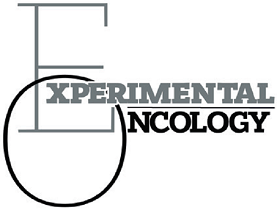ОКСАМАТ, ІНГІБІТОР ЛАКТАТДЕГІДРОГЕНАЗИ, МОЖЕ СТИМУЛЮВАТИ М2-ПОЛЯРИЗАЦІЮ ПЕРИТОНЕАЛЬНИХ МАКРОФАГІВ МИШЕЙ З КАРЦИНОМОЮ ЛЕГЕНІ ЛЬЮЇС
DOI:
https://doi.org/10.32471/exp-oncology.2312-8852.vol-43-no-3.16530Ключові слова:
інгібітор лактатдегідрогенази, оксамат, макрофаги, M2-поляризація, карцинома легені Льюїс.Анотація
Резюме. Стан питання: Інгібування аеробного гліколізу пухлинних клітин розглядають як перспективну терапевтичну стратегію в лікуванні раку. Деякі інгібітори енергетичного обміну можуть впливати не тільки на пухлинні клітини, але й на функціональну поляризацію асоційованих з пухлиною макрофагів, що може як посилювати, так і послаблювати протипухлинний ефект таких агентів. Мета: Дослідити вплив інгібітора лактатдегідрогенази (ЛДГ) оксамату на поляризацію перитонеальних макрофагів у інтактних мишей та у мишей з перещепленою карциномою легені Льюїс. Матеріали та методи: Самкам мишей C57Bl/6 перещеплювали варіант карциноми легені Льюїс із зниженою метастатичною активністю — LLC/R9. Оксамат натрію, як тестуючий агент, випробовували в концентраціях 0,02, 0,2 та 2 мг/мл. Поляризацію макрофагів інтактних мишей та мишей з пухлиною (на 23-тю добу після перещеплення) оцінювали за функціональними індексами поляризації: за продукцією оксиду азоту та за аргіназною активністю. Результати: Оксамат може впливати на функціональну поляризацію перитонеальних макрофагів як у інтактних мишей, так і у мишей з перещепленою LLC/R9. В усіх досліджених концентраціях оксамат змінював маркери поляризації макрофагів у інтактних мишей, що вказувало на стимулювання М2-поляризації. У мишей з пухлиною стимулювання М2-поляризації відзначали за низьких концентрацій оксамату (0,02 мг/мл), тоді як високі концентрації (2 мг/мл) спричинювали М1-поляризацію, яка характеризувалася трьохкратним збільшенням рівня NO та підвищенням рівня аргіназної активності. Висновки: Інгібітор ЛДГ оксамат може дозозалежно стимулювати М2-поляризацію макрофагів у мишей перещепленою карциномою легені Льюїс.
Посилання
Warburg O. On the origin of cancer cells. Science 1956; 123: 309–14. https://doi.org/10.1126/science.123.3191.309.
Feng Y, Xiong Y, Qiao T, et al. Lactate dehydrogenase A: a key player in carcinogenesis and potential target in cancer therapy. Cancer Med 2018; 7: 6124–36. https://doi.org/10.1002/cam4.1820.
Oshima N, Ishida R, Kishimoto S, et al. Dynamic imaging of LDH inhibition in tumors reveals rapid in vivo metabolic rewiring and vulnerability to combination. Cell Rep 2020; 30: 1798–810.e4. https://doi.org/10.1016/j.celrep.2020.01.039.
Rai G, Brimacombe KR, Mott BT, et al. Discovery and optimization of potent, cell-active pyrazole-based inhibitors of lactate dehydrogenase (LDH). J Med Chem 2017; 60: 9184–204. https://doi.org/10.1021/acs.jmedchem.7b00941.
Yeung C, Gibson AE, Issaq SH, et al. Targeting glycolysis through inhibition of lactate dehydrogenase impairs tumor growth in preclinical models of Ewing sarcoma. Cancer Res 2019; 79: 5060–73. https://doi.org/10.1158/0008-5472.CAN-19-0217.
Greten FR, Grivennikov SI. Inflammation and cancer: triggers, mechanisms, and consequences. Immunity 2019; 51: 27–41. https://doi.org/10.1016/j.immuni.2019.06.025.
Solinas G, Germano G, Mantovani A, et al. Tumor-associated macrophages (TAM) as major players of the cancer-related inflammation. J Leukoc Biol 2009; 86: 1065–73. https://doi.org/10.1189/jlb.0609385.
Wang H, Yung MMH, Ngan HYS, et al. The impact of the tumor microenvironment on macrophage polarization in cancer metastatic progression. Int J Mol Sci 2021; 22: 6560. https://doi.org/10.3390/ijms22126560.
Szebeni GJ, Vizler C, Kitajka K, et al. Inflammation and cancer: extra- and intracellular determinants of tumor-associated macrophages as tumor promoters. Mediators Inflamm 2017; 2017: 9294018. https://doi.org/10.1155/2017/9294018.
Mills CD, Kincaid K, Alt JM, et al. M-1/M-2 macrophages and the Th1/Th2 paradigm. J Immunol 2000; 164: 6166–73. https://doi.org/10.4049/jimmunol.164.12.6166.
Koo SJ, Garg NJ. Metabolic programming of macrophage functions and pathogens control. Redox Biol 2019; 24: 101198. https://doi.org/10.1016/j.redox.2019.101198.
Viola A, Munari F, Sánchez-Rodríguez R, et al. The metabolic signature of macrophage responses. Front Immunol 2019; 10: 1462. https://doi.org/10.3389/fimmu.2019.01462.
Boscá L, González-Ramos S, Prieto P, et al. Metabolic signatures linked to macrophage polarization: from glucose metabolism to oxidative phosphorylation. Biochem Soc Trans 2015; 43: 740–4. https://doi.org/10.1042/BST20150107.
El Kasmi KC, Stenmark KR. Contribution of metabolic reprogramming to macrophage plasticity and function. Semin Immunol 2015; 27: 267–75. https://doi.org/10.1016/j.smim.2015.09.001.
Boudreau A, Purkey HE, Hitz A, et al. Metabolic plasticity underpins innate and acquired resistance to LDHA inhibition. Nat Chem Biol 2016; 12: 779–86. https://doi.org/10.1038/nchembio.2143.
Chung TW, Kim EY, Han CW, et al. Machilin A inhibits tumor growth and macrophage M2 polarization through the reduction of lactic acid. Cancers 2019; 11: 963. https://doi.org/10.3390/cancers11070963.
Reiner NE, ed. Macrophages and dendritic cells: Methods and Protocols. NY, USA: Humana Press, 2009. 368 p.
Corraliza IM, Campo ML, Soler G, et al. Determination of arginase activity in macrophages: a micromethod. J Immunol Methods 1994; 174: 231–5. https://doi.org/10.1016/0022-1759(94)90027-2.
Munder M, Eichmann K, Moran JM, et al. Th1/Th2-regulated expression of arginase isoforms in murine macrophages and dendritic cells. J Immunol 1999; 163: 3771–7.
Pyaskovskaya ON, Dasyukevich OI, Kolesnik DL, et al. Changes in VEGF level and tumor growth characteristics during Lewis lung carcinoma progression towards cis-DDP resistance. Exp Oncol 2007; 29: 197–202.
Kolesnik DL, Pyaskovskaya ON, Tregubova NV, et al. Lewis lung carcinoma variant with a high sensitivity to antitumor antiangiogenic therapy exhibits a high capacity for autophagy. Cytol Genet 2012; 46: 155–60.
Pyaskovskaya ON, Kolesnik DL, Yanish Y, et al. Role of tumor/endothelial interactions in tumor growth and metastasis. Exp Oncol 2021; 43: 104–10. https://doi.org/10.32471/exp-oncology.2312-8852.vol-43-no-2.16157.
Fedorchuk OG, Pyaskovskaya OM, Skivka LM, et al. Paraneoplastic syndrome in mice bearing high-angiogenic variant of Lewis lung carcinoma: relations with tumor derived VEGF. Cytokine 2012; 57: 81–8. https://doi.org/10.1016/j.cyto.2011.10.022.
Zhai X, Yang Y, Wan J, et al. Inhibition of LDH-A by oxamate induces G2/M arrest, apoptosis and increases radiosensitivity in nasopharyngeal carcinoma cells. Oncol Rep 2013; 30: 2983–91. https://doi.org/10.3892/or.2013.2735.
Miskimins WK, Ahn HJ, Kim JY, et al. Synergistic anti-cancer effect of phenformin and oxamate. PLoS One 2014; 9: e85576. https://doi.org/10.1371/journal.pone.0085576.
García-Castillo V, López-Urrutia E, Villanueva-Sánchez O, et al. Targeting metabolic remodeling in triple negative breast cancer in a murine model. J Cancer 2017; 8: 178–89. https://doi.org/10.7150/jca.16387.
##submission.downloads##
Опубліковано
Як цитувати
Номер
Розділ
Ліцензія
Авторське право (c) 2023 Експериментальна онкологія

Ця робота ліцензується відповідно до Creative Commons Attribution-NonCommercial 4.0 International License.



